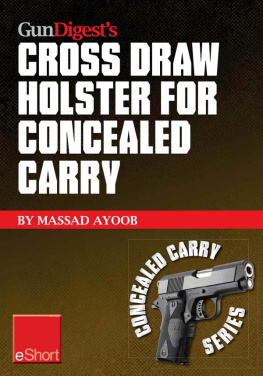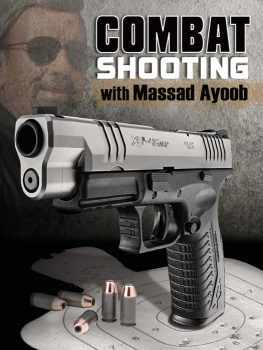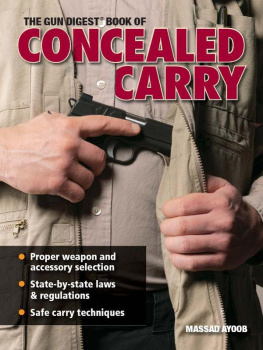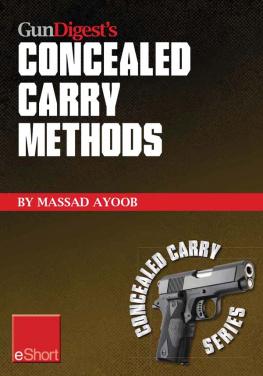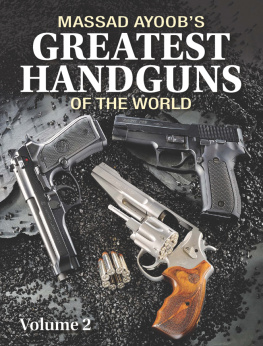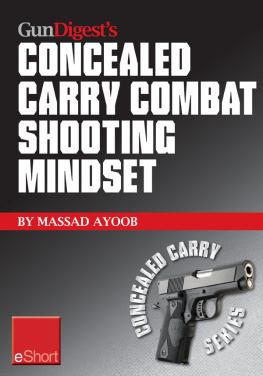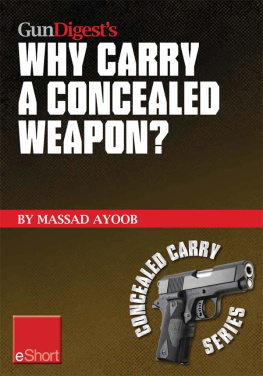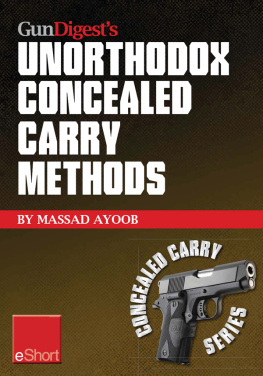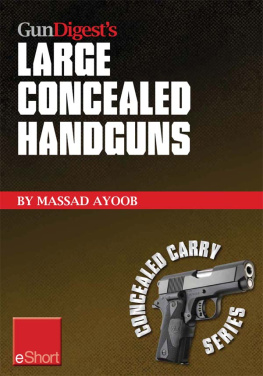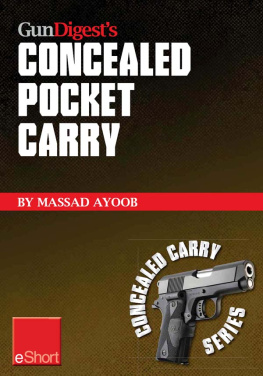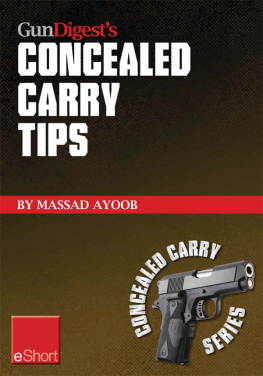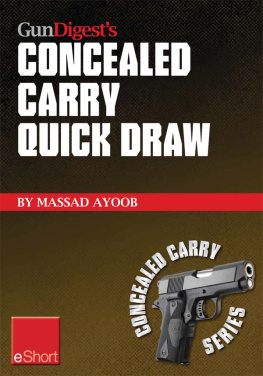Polymer-framed 9mm Kahr PM9 rides inside and below the waistband, and was designed for cross draw wear.
The cross draw holster carrying the handgun butt forward, on the hip opposite the dominant hand seems to be one of those love it or hate it issues among experienced pistoleros. There are several handgun sports that actually ban them as safety hazards. But there are also some folks out there who find them perfect for their needs.
Lets look at the upsides and downsides, and at how to streamline the cross draw concept in ways that may help get past the concerns of the detractors. First, lets define some terms.
pistol is drawn across chest, rocking up toward threat
and body is ideally positioned for classic Weaver stance.
Assorted Cross Draw Concepts
There are cross draws, and there are cross draws.
Conventional cross draw generally puts the gun all the way over on the opposite hip.
Front cross draw brings the gun to a point between hip and belt buckle, what would be the appendix position for a southpaw. This was the position once favored by IPSC shooters, and by the Illinois State Police back in the Seventies and earlier. Its also a favorite location for belly-band carry.
This is also a top choice for placing the second single-action revolver required in Cowboy Action shooting.
Fanny packs are often worn in a position that, effectively, puts them in a cross draw location.
Shoulder holsters require a variation of cross draw to bring the handgun into action.
Backup gun rigs attached to body armor are normally worn like vertical shoulder holsters, and therefore call for cross draw techniques and tactics.
The Kramer Confidante, a tee-shirt with built-in gun pockets under the armpits, is designed for wear under a dress shirt or casual shirt. The draw is the same as that from a conventional shoulder holster: a variation of cross draw.
Slider loop in right (forward) slot of Blocker DA-2 hip holster is moved up to orient the holster in a vertical position, ideal for cross-draw carry. Pistol is Glock 17 full-size 9mm with Heinie night sights.
Cross Draw Advantages
Many of those who choose the cross draw do it because of range of movement issues. Proportionally more female than male cops and CCW civilians carry cross draw than their male counterparts. This is because with a female and a male of the same height, you can expect the woman to have a shorter torso, a higher pelvis, and relatively longer and more limber arms (vis--vis the torso) than men. A woman can reach farther under her off-side arm for a shoulder holster, and farther toward her opposite side hip, for these reasons. A cross draw belt holster or shoulder rig that might be literally out of reach of a brawny, broad-shouldered man might be perfectly accessible when worn by his sister.
For women, the cross draw is also an alternative to the problems that come with strong-side hip holsters that have been designed by men, for men. The higher hips and more pronounced buttocks of the average woman push the muzzle area of a strong-side holster outward, which concomitantly pushes the butt in toward the body. Because of the higher belt line, a gun handle that sits comfortably in the hollow beneath a mans ribcage can press with excruciating discomfort into a womans ribs. When the most popular solution doesnt work, you need to explore less popular alternatives, and cross draw/shoulder carry is one.
Its not just a womans issue. One of my fellow gun writers has some serious arthritic issues that limit the range of movement of his shoulder. He finds the conventional hip holsters of his youth to be awkward and uncomfortable, and excruciatingly slow. So, he wears his sidearm, usually a 1911 45 auto, cross draw on the opposite hip. Voila: problem solved.
Many bodyguard chauffeurs and others who must constantly be seated, especially at the wheel of an automobile, have come to appreciate across-the-body carry. Many types of car seats inhibit the elbows flexion and therefore the reach of the gun hand when going for a strong-side hip scabbard while sitting in a vehicle. A quick reach down across the front of the body is generally faster. In the 1990s, a new breed of holster called the counter-car-jack rig made a brief appearance, though it did not seem to catch on. It held the pistol butt down, with the barrel almost horizontal, just to the off-side of midline of the abdomen. Men behind the wheel found it deadly fast. It did, however, have some downsides when one got out of the vehicle.
Hunting advantages. In the game fields, I learned to appreciate a sidearm in a cross draw holster. If it was backup to a long gun, the main guns stock was no longer banging into the handguns butt all the time. If travel involved ATVs and such, the cross draw seemed more accessible. Shoulder holsters have always been hunting favorites because the outer coat totally protects even big handguns from inclement weather.
Im not a horseman the closest Ive come to hunting with a horse has been driving to the deer woods in a Ford Bronco but friends who have hunted a lot on horseback tell me the cross draw is much more accessible to a person in the saddle. This is one reason cross draw was so popular among genuine cowboys in the Old West. At the OK Corral shootout, witnesses said Billy Clanton drew his 44-40 Colt Frontier Six-Shooter from a cross draw rig. And he was pretty quick with it. Wyatt Earp had gone into the fight with his own Colt 45 in the capacious, custom-made pocket of his overcoat, with his hand on the gun to start. Yet, when Clanton went to draw, he was so fast from his cross draw scabbard that both Wyatt and Virgil Earp testified later that Billy and Wyatt had fired simultaneously at the opening moment of the gunfight.
Weak hand accessibility. If you need to get to your sidearm with your non-dominant hand, nothing is faster than a gun already holstered on that hands side. With a regular cross draw rig on the belt, you simply use the cavalry draw. Turn your weak hand so the thumb is pointing to the rear and the metacarpal bones are toward your torso. Grab the pistol and lift. As it starts to clear the holster, point the muzzle down in front of you. The gun will now be upside-down. Rotate your hand to conventional gun orientation as you bring it up on target, and youll avoid the common cavalry draw mistake of crossing your own body with the gun muzzle.
Is this fast? Well, on the Old West frontier, there were those who carried their guns butt forward and always did a cavalry draw from them! These included the men of the U.S. Cavalry itself, who carried their sabers on their left hips positioned for draw with the presumed-to-be-dominant right hand, and their service revolvers on their right hips in butt-forward flap holsters. The rationale was that if the cavalry trooper needed a weapon in either hand, a revolver was easier to manipulate with the weak hand than a saber, and a conventional cross draw would be executed with the weak hand. If the dominant hand reached for the gun, it would do so with the cavalry draw described above.

